Analyzing Care Act 2014 and Professional Relationships in H+SC Sector
VerifiedAdded on 2023/06/14
|12
|2456
|156
Report
AI Summary
This report delves into the Care Act 2014 and its influence on professional relationships within the health and social care sector. It examines theories of communication, teamwork, and motivation, highlighting the importance of collaborative working and conflict management. The report analyzes the impact of professional relationships on improving care standards, particularly within the NHS, and discusses barriers to developing these relationships. It concludes that effective conflict management, teamwork, and communication, underpinned by motivational strategies, are crucial for fostering collaboration and enhancing service delivery in health and social care. Desklib offers a wealth of resources, including past papers and solved assignments, to further support students in understanding these complex topics.
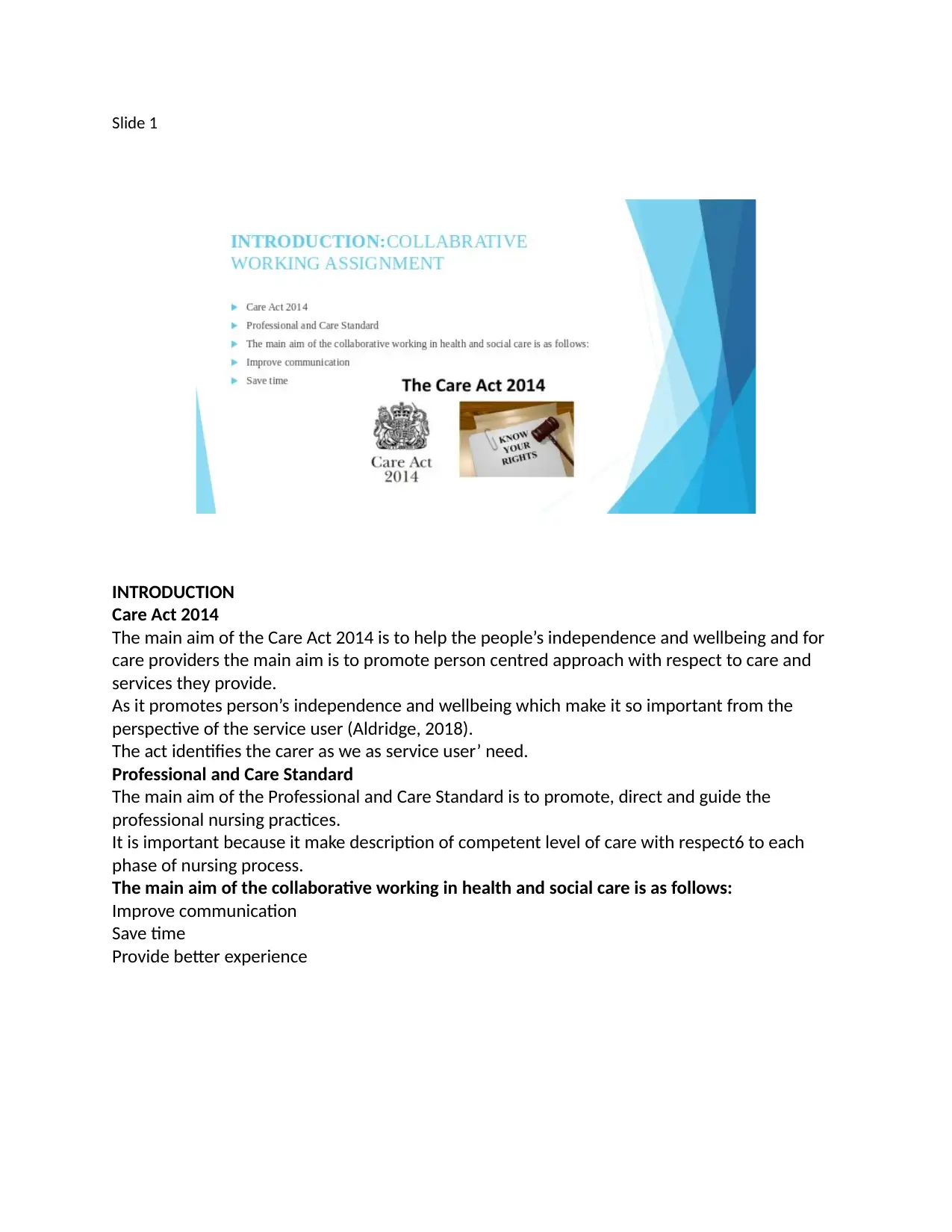
Slide 1
INTRODUCTION
Care Act 2014
The main aim of the Care Act 2014 is to help the people’s independence and wellbeing and for
care providers the main aim is to promote person centred approach with respect to care and
services they provide.
As it promotes person’s independence and wellbeing which make it so important from the
perspective of the service user (Aldridge, 2018).
The act identifies the carer as we as service user’ need.
Professional and Care Standard
The main aim of the Professional and Care Standard is to promote, direct and guide the
professional nursing practices.
It is important because it make description of competent level of care with respect6 to each
phase of nursing process.
The main aim of the collaborative working in health and social care is as follows:
Improve communication
Save time
Provide better experience
INTRODUCTION
Care Act 2014
The main aim of the Care Act 2014 is to help the people’s independence and wellbeing and for
care providers the main aim is to promote person centred approach with respect to care and
services they provide.
As it promotes person’s independence and wellbeing which make it so important from the
perspective of the service user (Aldridge, 2018).
The act identifies the carer as we as service user’ need.
Professional and Care Standard
The main aim of the Professional and Care Standard is to promote, direct and guide the
professional nursing practices.
It is important because it make description of competent level of care with respect6 to each
phase of nursing process.
The main aim of the collaborative working in health and social care is as follows:
Improve communication
Save time
Provide better experience
Paraphrase This Document
Need a fresh take? Get an instant paraphrase of this document with our AI Paraphraser
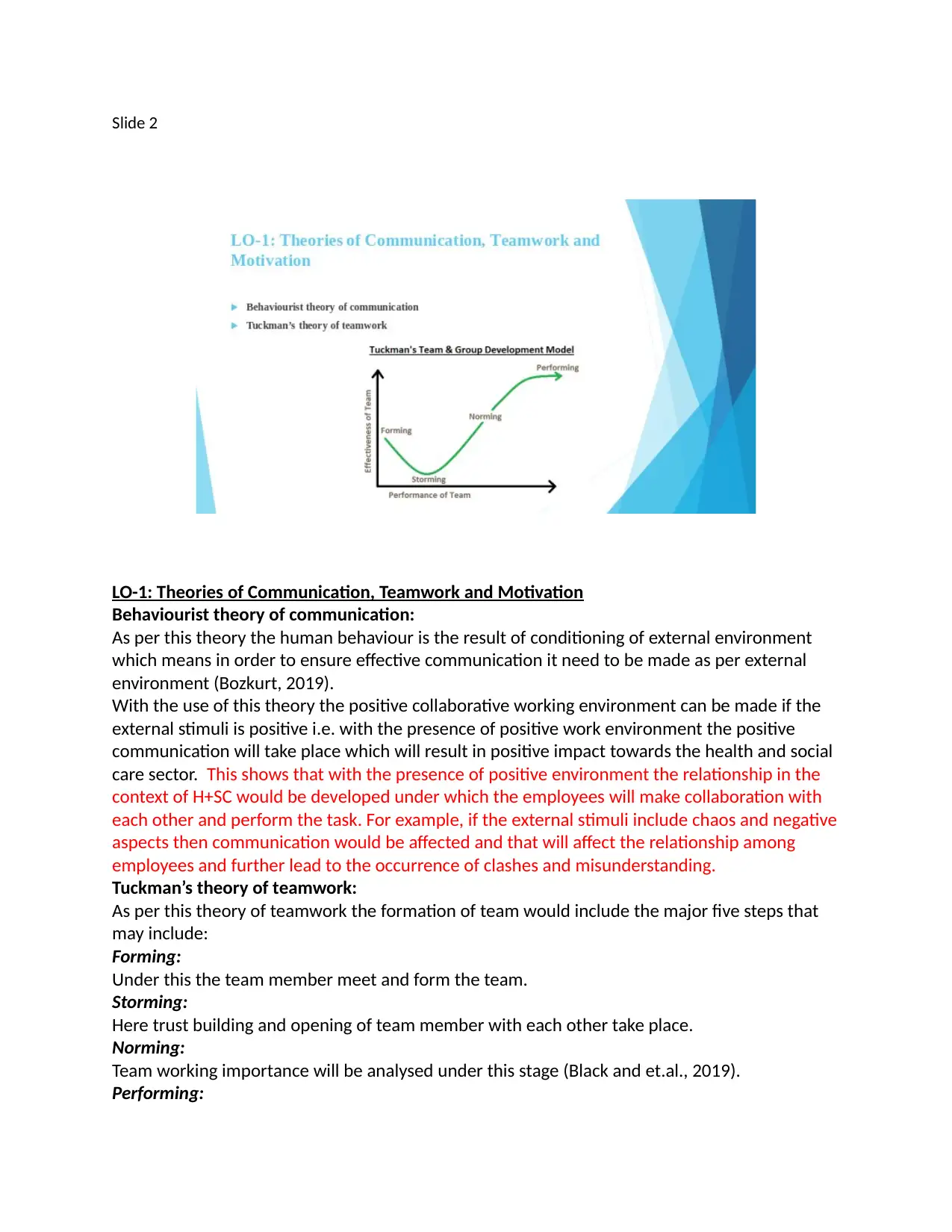
Slide 2
LO-1: Theories of Communication, Teamwork and Motivation
Behaviourist theory of communication:
As per this theory the human behaviour is the result of conditioning of external environment
which means in order to ensure effective communication it need to be made as per external
environment (Bozkurt, 2019).
With the use of this theory the positive collaborative working environment can be made if the
external stimuli is positive i.e. with the presence of positive work environment the positive
communication will take place which will result in positive impact towards the health and social
care sector. This shows that with the presence of positive environment the relationship in the
context of H+SC would be developed under which the employees will make collaboration with
each other and perform the task. For example, if the external stimuli include chaos and negative
aspects then communication would be affected and that will affect the relationship among
employees and further lead to the occurrence of clashes and misunderstanding.
Tuckman’s theory of teamwork:
As per this theory of teamwork the formation of team would include the major five steps that
may include:
Forming:
Under this the team member meet and form the team.
Storming:
Here trust building and opening of team member with each other take place.
Norming:
Team working importance will be analysed under this stage (Black and et.al., 2019).
Performing:
LO-1: Theories of Communication, Teamwork and Motivation
Behaviourist theory of communication:
As per this theory the human behaviour is the result of conditioning of external environment
which means in order to ensure effective communication it need to be made as per external
environment (Bozkurt, 2019).
With the use of this theory the positive collaborative working environment can be made if the
external stimuli is positive i.e. with the presence of positive work environment the positive
communication will take place which will result in positive impact towards the health and social
care sector. This shows that with the presence of positive environment the relationship in the
context of H+SC would be developed under which the employees will make collaboration with
each other and perform the task. For example, if the external stimuli include chaos and negative
aspects then communication would be affected and that will affect the relationship among
employees and further lead to the occurrence of clashes and misunderstanding.
Tuckman’s theory of teamwork:
As per this theory of teamwork the formation of team would include the major five steps that
may include:
Forming:
Under this the team member meet and form the team.
Storming:
Here trust building and opening of team member with each other take place.
Norming:
Team working importance will be analysed under this stage (Black and et.al., 2019).
Performing:
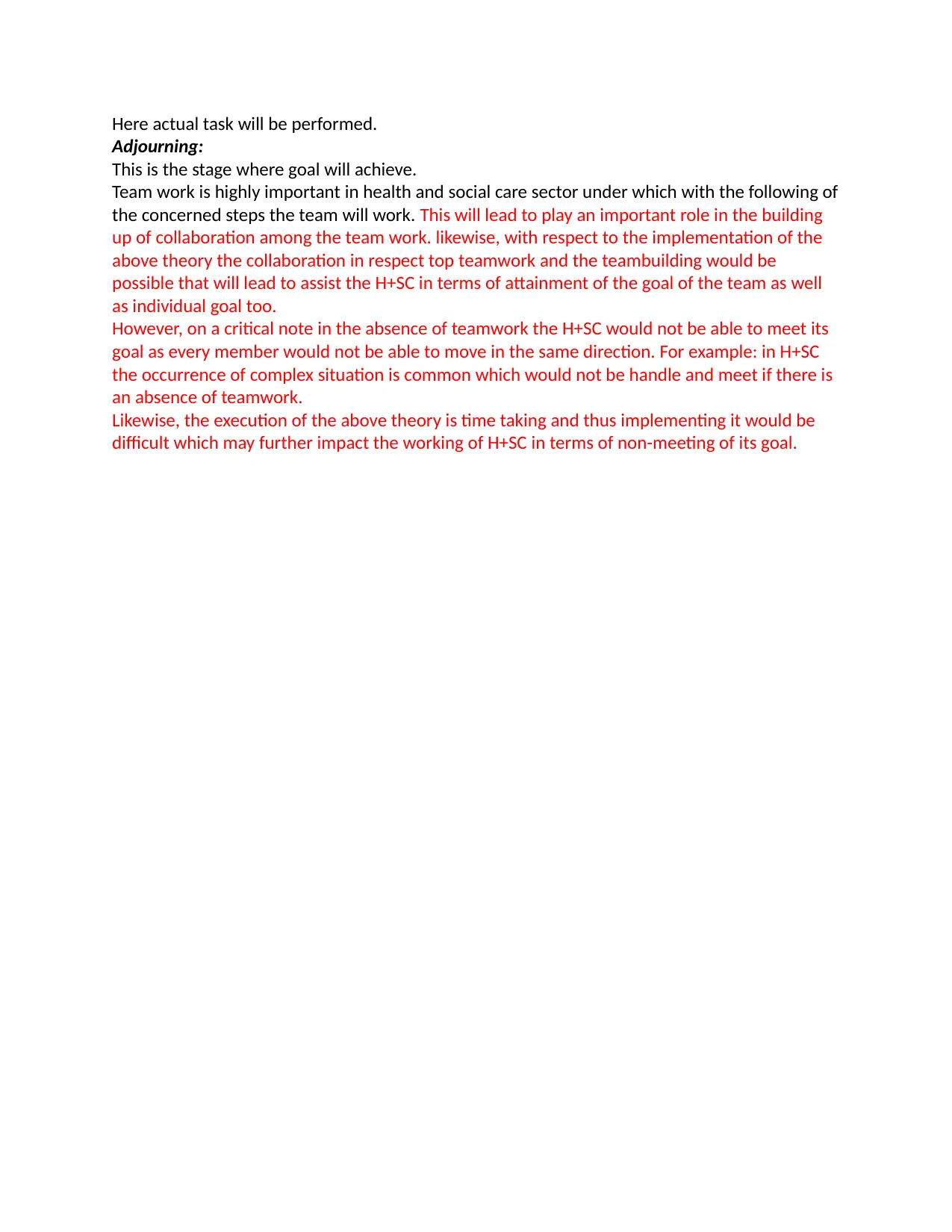
Here actual task will be performed.
Adjourning:
This is the stage where goal will achieve.
Team work is highly important in health and social care sector under which with the following of
the concerned steps the team will work. This will lead to play an important role in the building
up of collaboration among the team work. likewise, with respect to the implementation of the
above theory the collaboration in respect top teamwork and the teambuilding would be
possible that will lead to assist the H+SC in terms of attainment of the goal of the team as well
as individual goal too.
However, on a critical note in the absence of teamwork the H+SC would not be able to meet its
goal as every member would not be able to move in the same direction. For example: in H+SC
the occurrence of complex situation is common which would not be handle and meet if there is
an absence of teamwork.
Likewise, the execution of the above theory is time taking and thus implementing it would be
difficult which may further impact the working of H+SC in terms of non-meeting of its goal.
Adjourning:
This is the stage where goal will achieve.
Team work is highly important in health and social care sector under which with the following of
the concerned steps the team will work. This will lead to play an important role in the building
up of collaboration among the team work. likewise, with respect to the implementation of the
above theory the collaboration in respect top teamwork and the teambuilding would be
possible that will lead to assist the H+SC in terms of attainment of the goal of the team as well
as individual goal too.
However, on a critical note in the absence of teamwork the H+SC would not be able to meet its
goal as every member would not be able to move in the same direction. For example: in H+SC
the occurrence of complex situation is common which would not be handle and meet if there is
an absence of teamwork.
Likewise, the execution of the above theory is time taking and thus implementing it would be
difficult which may further impact the working of H+SC in terms of non-meeting of its goal.
⊘ This is a preview!⊘
Do you want full access?
Subscribe today to unlock all pages.

Trusted by 1+ million students worldwide
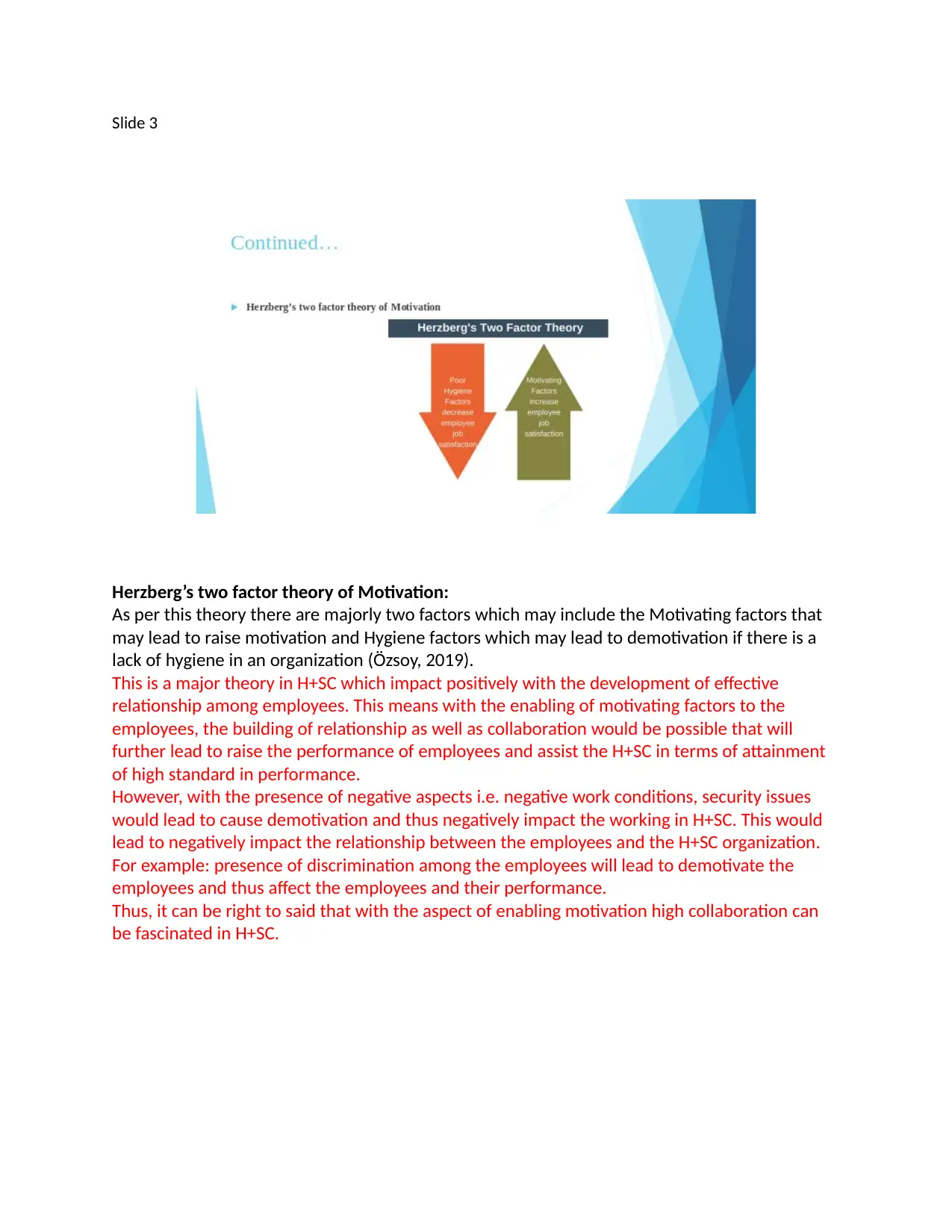
Slide 3
Herzberg’s two factor theory of Motivation:
As per this theory there are majorly two factors which may include the Motivating factors that
may lead to raise motivation and Hygiene factors which may lead to demotivation if there is a
lack of hygiene in an organization (Özsoy, 2019).
This is a major theory in H+SC which impact positively with the development of effective
relationship among employees. This means with the enabling of motivating factors to the
employees, the building of relationship as well as collaboration would be possible that will
further lead to raise the performance of employees and assist the H+SC in terms of attainment
of high standard in performance.
However, with the presence of negative aspects i.e. negative work conditions, security issues
would lead to cause demotivation and thus negatively impact the working in H+SC. This would
lead to negatively impact the relationship between the employees and the H+SC organization.
For example: presence of discrimination among the employees will lead to demotivate the
employees and thus affect the employees and their performance.
Thus, it can be right to said that with the aspect of enabling motivation high collaboration can
be fascinated in H+SC.
Herzberg’s two factor theory of Motivation:
As per this theory there are majorly two factors which may include the Motivating factors that
may lead to raise motivation and Hygiene factors which may lead to demotivation if there is a
lack of hygiene in an organization (Özsoy, 2019).
This is a major theory in H+SC which impact positively with the development of effective
relationship among employees. This means with the enabling of motivating factors to the
employees, the building of relationship as well as collaboration would be possible that will
further lead to raise the performance of employees and assist the H+SC in terms of attainment
of high standard in performance.
However, with the presence of negative aspects i.e. negative work conditions, security issues
would lead to cause demotivation and thus negatively impact the working in H+SC. This would
lead to negatively impact the relationship between the employees and the H+SC organization.
For example: presence of discrimination among the employees will lead to demotivate the
employees and thus affect the employees and their performance.
Thus, it can be right to said that with the aspect of enabling motivation high collaboration can
be fascinated in H+SC.
Paraphrase This Document
Need a fresh take? Get an instant paraphrase of this document with our AI Paraphraser
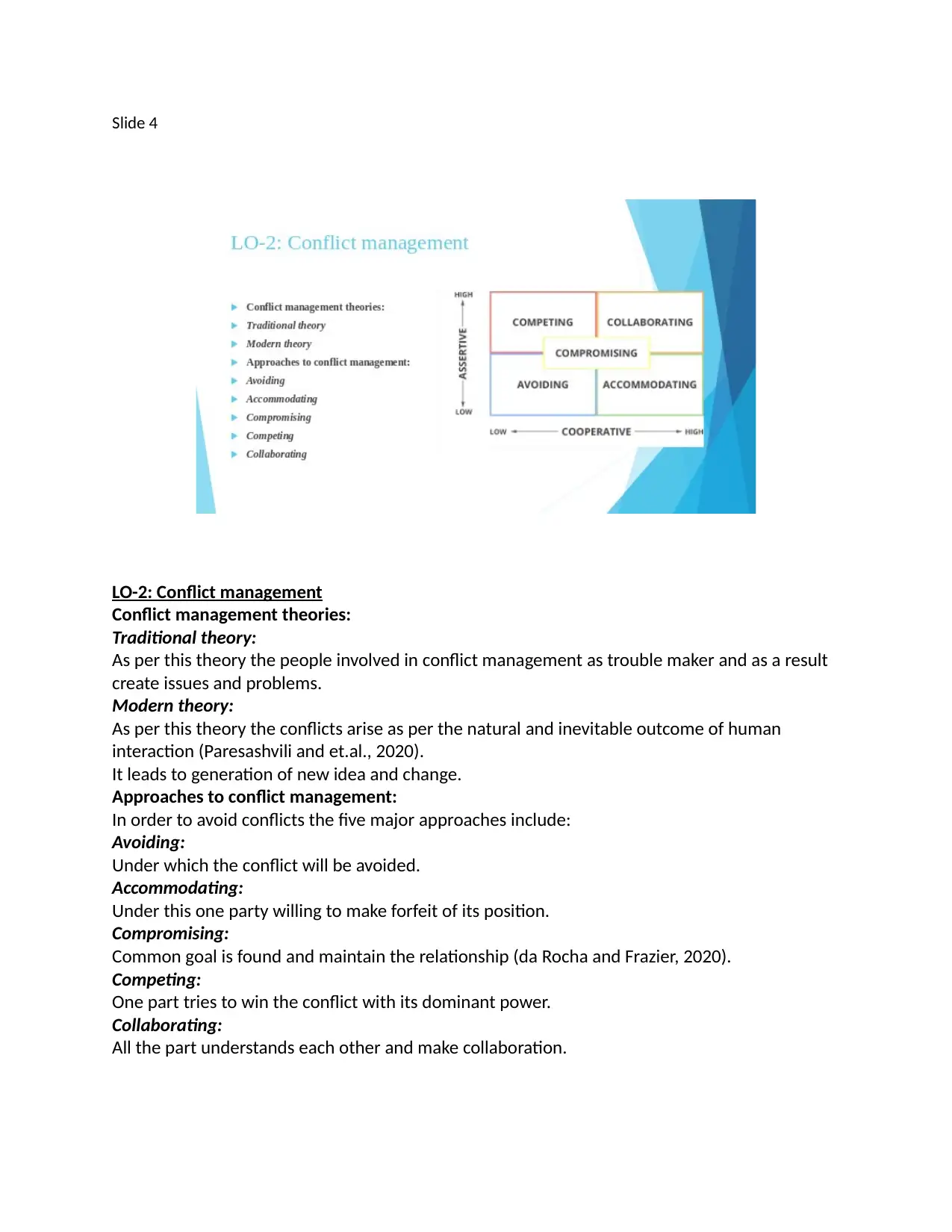
Slide 4
LO-2: Conflict management
Conflict management theories:
Traditional theory:
As per this theory the people involved in conflict management as trouble maker and as a result
create issues and problems.
Modern theory:
As per this theory the conflicts arise as per the natural and inevitable outcome of human
interaction (Paresashvili and et.al., 2020).
It leads to generation of new idea and change.
Approaches to conflict management:
In order to avoid conflicts the five major approaches include:
Avoiding:
Under which the conflict will be avoided.
Accommodating:
Under this one party willing to make forfeit of its position.
Compromising:
Common goal is found and maintain the relationship (da Rocha and Frazier, 2020).
Competing:
One part tries to win the conflict with its dominant power.
Collaborating:
All the part understands each other and make collaboration.
LO-2: Conflict management
Conflict management theories:
Traditional theory:
As per this theory the people involved in conflict management as trouble maker and as a result
create issues and problems.
Modern theory:
As per this theory the conflicts arise as per the natural and inevitable outcome of human
interaction (Paresashvili and et.al., 2020).
It leads to generation of new idea and change.
Approaches to conflict management:
In order to avoid conflicts the five major approaches include:
Avoiding:
Under which the conflict will be avoided.
Accommodating:
Under this one party willing to make forfeit of its position.
Compromising:
Common goal is found and maintain the relationship (da Rocha and Frazier, 2020).
Competing:
One part tries to win the conflict with its dominant power.
Collaborating:
All the part understands each other and make collaboration.
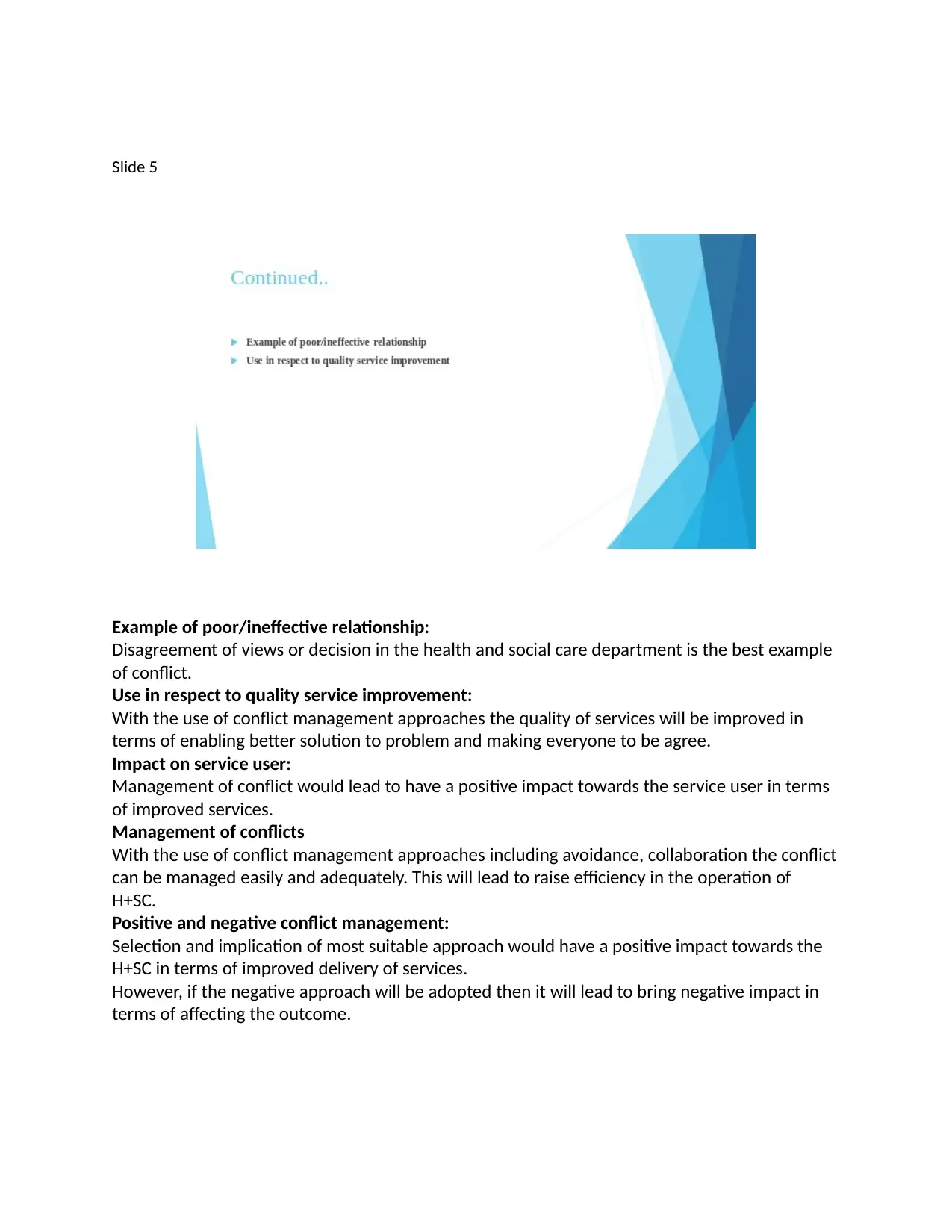
Slide 5
Example of poor/ineffective relationship:
Disagreement of views or decision in the health and social care department is the best example
of conflict.
Use in respect to quality service improvement:
With the use of conflict management approaches the quality of services will be improved in
terms of enabling better solution to problem and making everyone to be agree.
Impact on service user:
Management of conflict would lead to have a positive impact towards the service user in terms
of improved services.
Management of conflicts
With the use of conflict management approaches including avoidance, collaboration the conflict
can be managed easily and adequately. This will lead to raise efficiency in the operation of
H+SC.
Positive and negative conflict management:
Selection and implication of most suitable approach would have a positive impact towards the
H+SC in terms of improved delivery of services.
However, if the negative approach will be adopted then it will lead to bring negative impact in
terms of affecting the outcome.
Example of poor/ineffective relationship:
Disagreement of views or decision in the health and social care department is the best example
of conflict.
Use in respect to quality service improvement:
With the use of conflict management approaches the quality of services will be improved in
terms of enabling better solution to problem and making everyone to be agree.
Impact on service user:
Management of conflict would lead to have a positive impact towards the service user in terms
of improved services.
Management of conflicts
With the use of conflict management approaches including avoidance, collaboration the conflict
can be managed easily and adequately. This will lead to raise efficiency in the operation of
H+SC.
Positive and negative conflict management:
Selection and implication of most suitable approach would have a positive impact towards the
H+SC in terms of improved delivery of services.
However, if the negative approach will be adopted then it will lead to bring negative impact in
terms of affecting the outcome.
⊘ This is a preview!⊘
Do you want full access?
Subscribe today to unlock all pages.

Trusted by 1+ million students worldwide
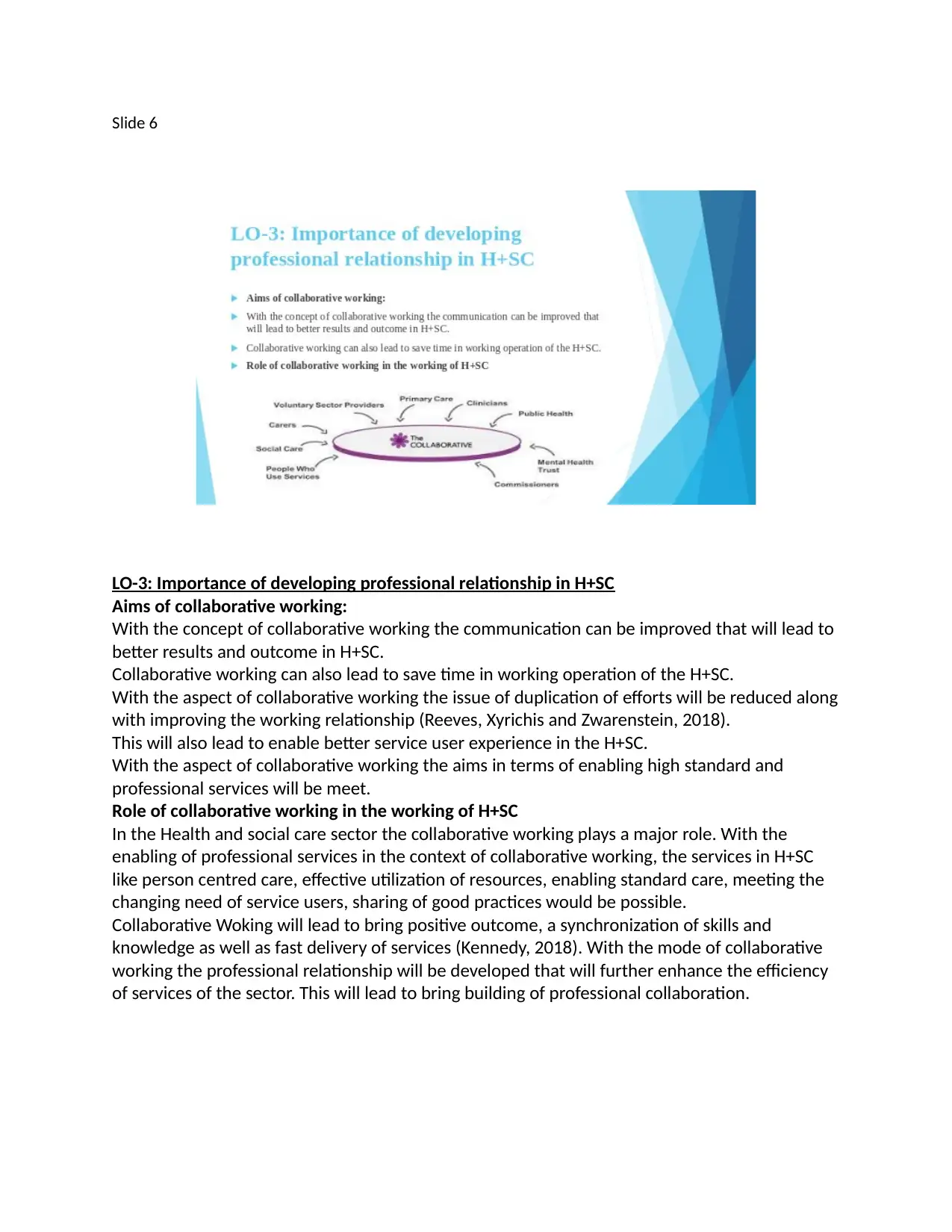
Slide 6
LO-3: Importance of developing professional relationship in H+SC
Aims of collaborative working:
With the concept of collaborative working the communication can be improved that will lead to
better results and outcome in H+SC.
Collaborative working can also lead to save time in working operation of the H+SC.
With the aspect of collaborative working the issue of duplication of efforts will be reduced along
with improving the working relationship (Reeves, Xyrichis and Zwarenstein, 2018).
This will also lead to enable better service user experience in the H+SC.
With the aspect of collaborative working the aims in terms of enabling high standard and
professional services will be meet.
Role of collaborative working in the working of H+SC
In the Health and social care sector the collaborative working plays a major role. With the
enabling of professional services in the context of collaborative working, the services in H+SC
like person centred care, effective utilization of resources, enabling standard care, meeting the
changing need of service users, sharing of good practices would be possible.
Collaborative Woking will lead to bring positive outcome, a synchronization of skills and
knowledge as well as fast delivery of services (Kennedy, 2018). With the mode of collaborative
working the professional relationship will be developed that will further enhance the efficiency
of services of the sector. This will lead to bring building of professional collaboration.
LO-3: Importance of developing professional relationship in H+SC
Aims of collaborative working:
With the concept of collaborative working the communication can be improved that will lead to
better results and outcome in H+SC.
Collaborative working can also lead to save time in working operation of the H+SC.
With the aspect of collaborative working the issue of duplication of efforts will be reduced along
with improving the working relationship (Reeves, Xyrichis and Zwarenstein, 2018).
This will also lead to enable better service user experience in the H+SC.
With the aspect of collaborative working the aims in terms of enabling high standard and
professional services will be meet.
Role of collaborative working in the working of H+SC
In the Health and social care sector the collaborative working plays a major role. With the
enabling of professional services in the context of collaborative working, the services in H+SC
like person centred care, effective utilization of resources, enabling standard care, meeting the
changing need of service users, sharing of good practices would be possible.
Collaborative Woking will lead to bring positive outcome, a synchronization of skills and
knowledge as well as fast delivery of services (Kennedy, 2018). With the mode of collaborative
working the professional relationship will be developed that will further enhance the efficiency
of services of the sector. This will lead to bring building of professional collaboration.
Paraphrase This Document
Need a fresh take? Get an instant paraphrase of this document with our AI Paraphraser
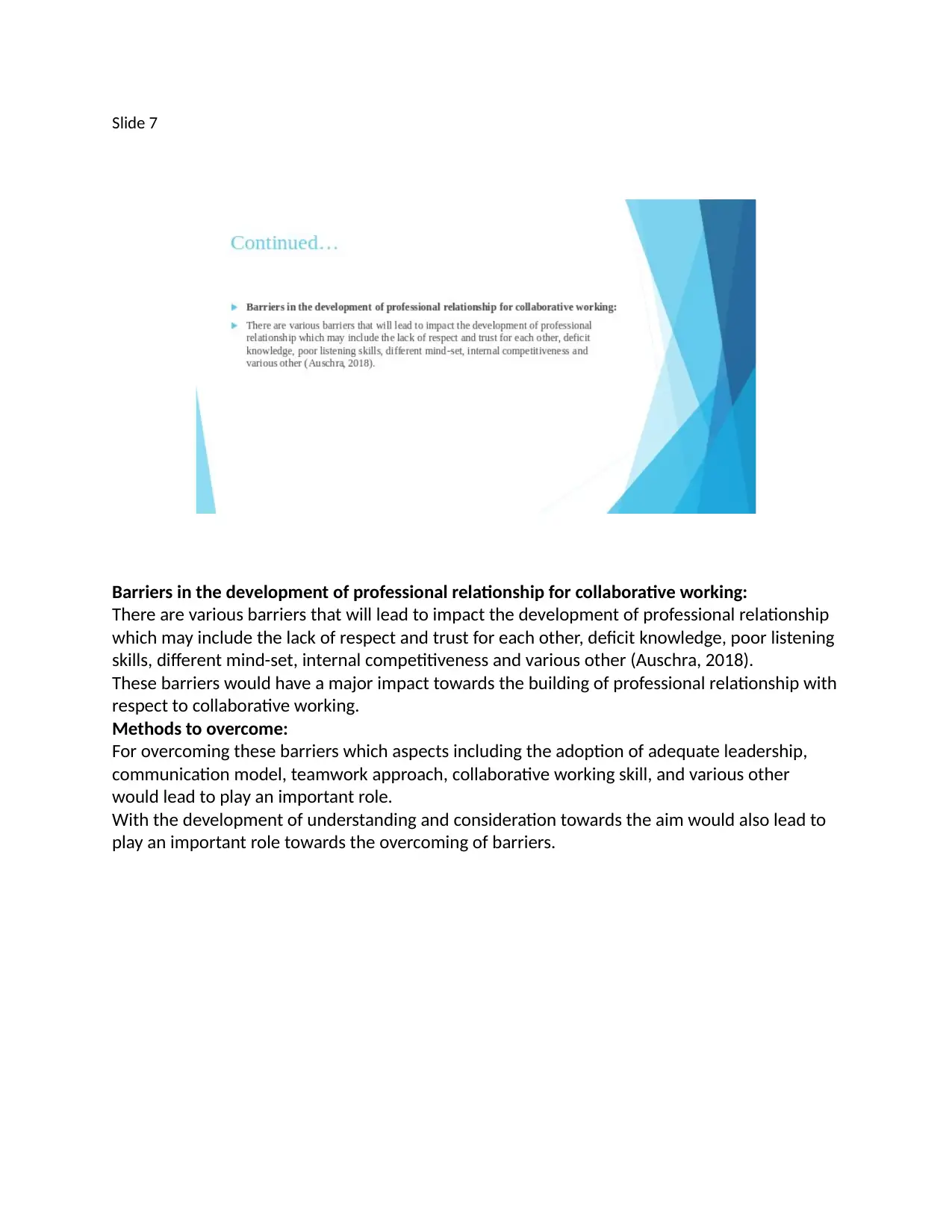
Slide 7
Barriers in the development of professional relationship for collaborative working:
There are various barriers that will lead to impact the development of professional relationship
which may include the lack of respect and trust for each other, deficit knowledge, poor listening
skills, different mind-set, internal competitiveness and various other (Auschra, 2018).
These barriers would have a major impact towards the building of professional relationship with
respect to collaborative working.
Methods to overcome:
For overcoming these barriers which aspects including the adoption of adequate leadership,
communication model, teamwork approach, collaborative working skill, and various other
would lead to play an important role.
With the development of understanding and consideration towards the aim would also lead to
play an important role towards the overcoming of barriers.
Barriers in the development of professional relationship for collaborative working:
There are various barriers that will lead to impact the development of professional relationship
which may include the lack of respect and trust for each other, deficit knowledge, poor listening
skills, different mind-set, internal competitiveness and various other (Auschra, 2018).
These barriers would have a major impact towards the building of professional relationship with
respect to collaborative working.
Methods to overcome:
For overcoming these barriers which aspects including the adoption of adequate leadership,
communication model, teamwork approach, collaborative working skill, and various other
would lead to play an important role.
With the development of understanding and consideration towards the aim would also lead to
play an important role towards the overcoming of barriers.
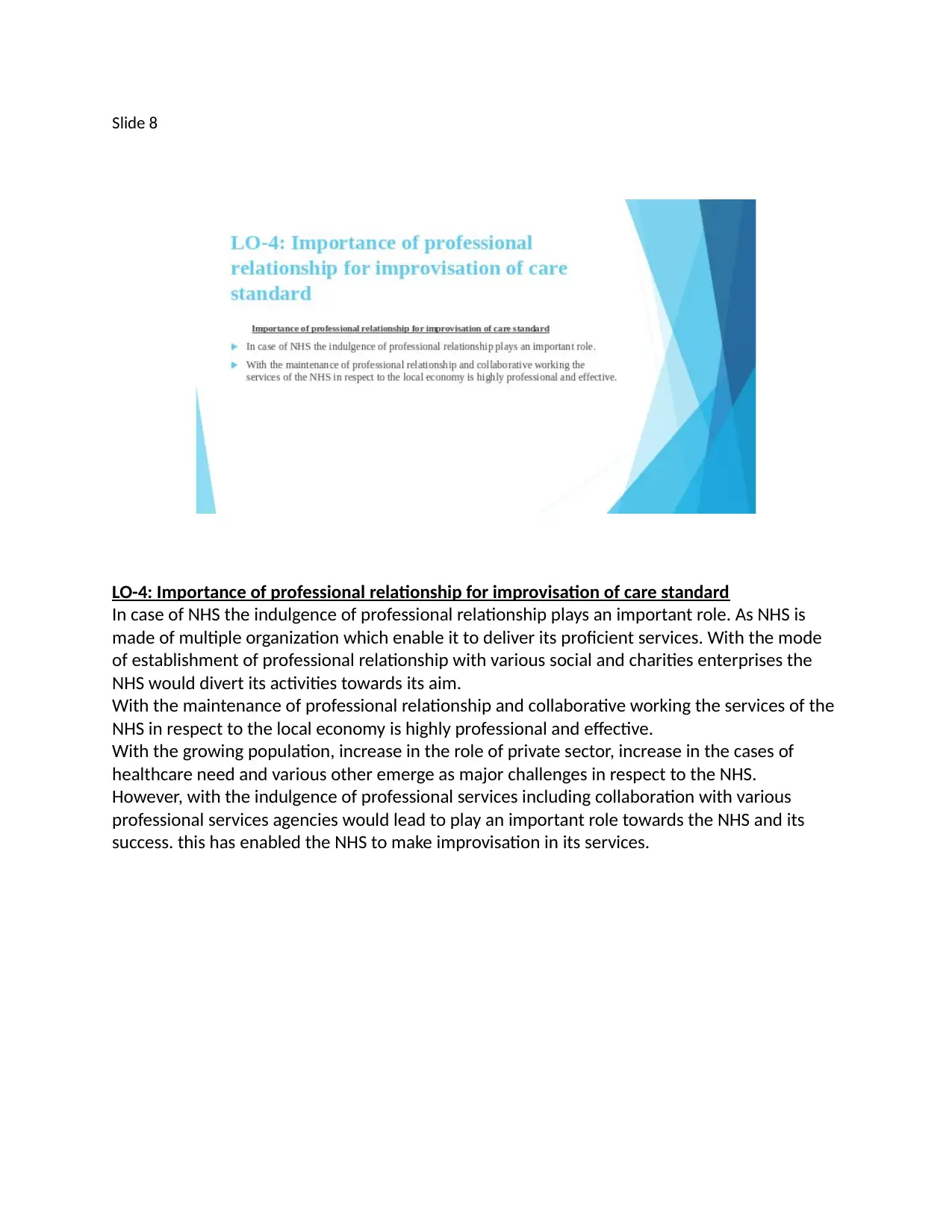
Slide 8
LO-4: Importance of professional relationship for improvisation of care standard
In case of NHS the indulgence of professional relationship plays an important role. As NHS is
made of multiple organization which enable it to deliver its proficient services. With the mode
of establishment of professional relationship with various social and charities enterprises the
NHS would divert its activities towards its aim.
With the maintenance of professional relationship and collaborative working the services of the
NHS in respect to the local economy is highly professional and effective.
With the growing population, increase in the role of private sector, increase in the cases of
healthcare need and various other emerge as major challenges in respect to the NHS.
However, with the indulgence of professional services including collaboration with various
professional services agencies would lead to play an important role towards the NHS and its
success. this has enabled the NHS to make improvisation in its services.
LO-4: Importance of professional relationship for improvisation of care standard
In case of NHS the indulgence of professional relationship plays an important role. As NHS is
made of multiple organization which enable it to deliver its proficient services. With the mode
of establishment of professional relationship with various social and charities enterprises the
NHS would divert its activities towards its aim.
With the maintenance of professional relationship and collaborative working the services of the
NHS in respect to the local economy is highly professional and effective.
With the growing population, increase in the role of private sector, increase in the cases of
healthcare need and various other emerge as major challenges in respect to the NHS.
However, with the indulgence of professional services including collaboration with various
professional services agencies would lead to play an important role towards the NHS and its
success. this has enabled the NHS to make improvisation in its services.
⊘ This is a preview!⊘
Do you want full access?
Subscribe today to unlock all pages.

Trusted by 1+ million students worldwide
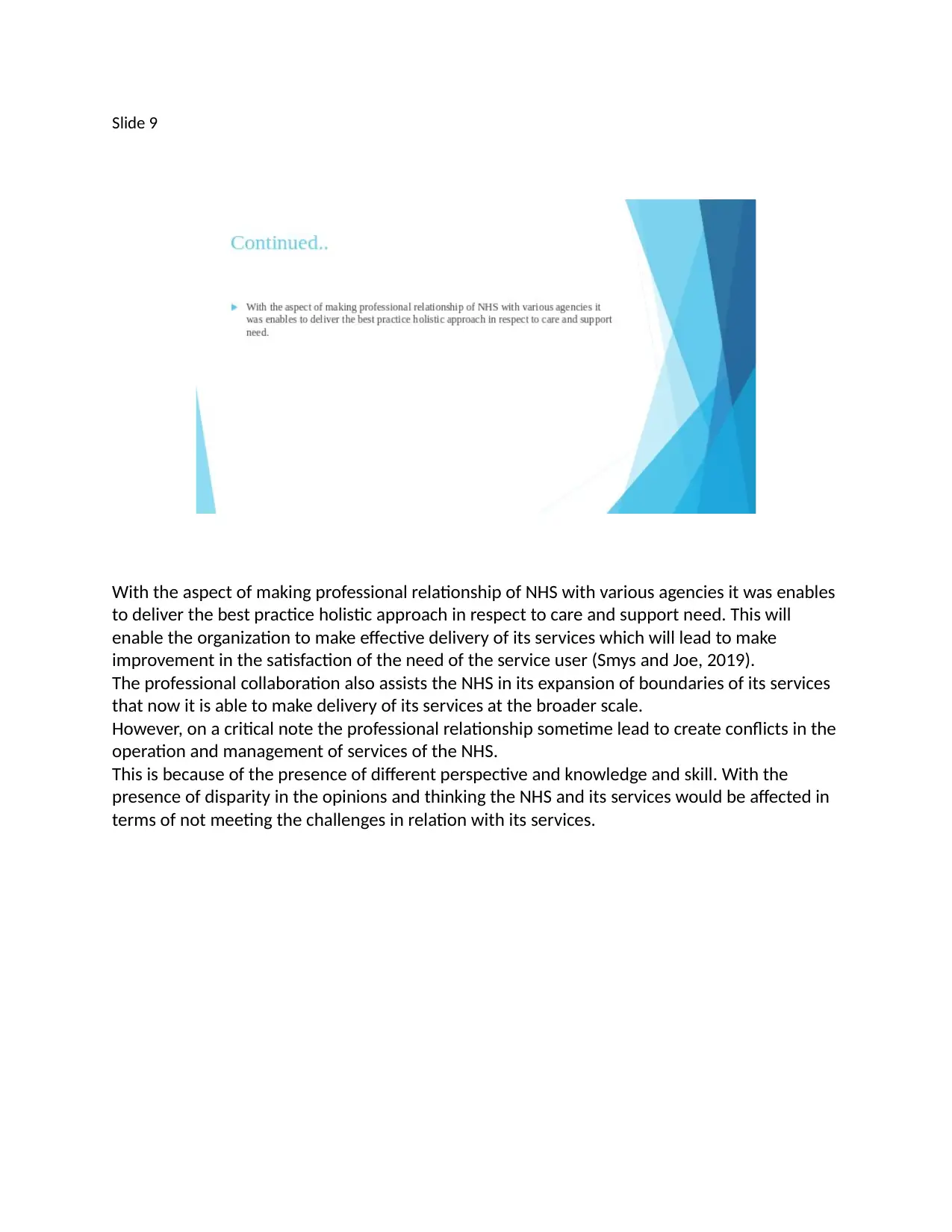
Slide 9
With the aspect of making professional relationship of NHS with various agencies it was enables
to deliver the best practice holistic approach in respect to care and support need. This will
enable the organization to make effective delivery of its services which will lead to make
improvement in the satisfaction of the need of the service user (Smys and Joe, 2019).
The professional collaboration also assists the NHS in its expansion of boundaries of its services
that now it is able to make delivery of its services at the broader scale.
However, on a critical note the professional relationship sometime lead to create conflicts in the
operation and management of services of the NHS.
This is because of the presence of different perspective and knowledge and skill. With the
presence of disparity in the opinions and thinking the NHS and its services would be affected in
terms of not meeting the challenges in relation with its services.
With the aspect of making professional relationship of NHS with various agencies it was enables
to deliver the best practice holistic approach in respect to care and support need. This will
enable the organization to make effective delivery of its services which will lead to make
improvement in the satisfaction of the need of the service user (Smys and Joe, 2019).
The professional collaboration also assists the NHS in its expansion of boundaries of its services
that now it is able to make delivery of its services at the broader scale.
However, on a critical note the professional relationship sometime lead to create conflicts in the
operation and management of services of the NHS.
This is because of the presence of different perspective and knowledge and skill. With the
presence of disparity in the opinions and thinking the NHS and its services would be affected in
terms of not meeting the challenges in relation with its services.
Paraphrase This Document
Need a fresh take? Get an instant paraphrase of this document with our AI Paraphraser
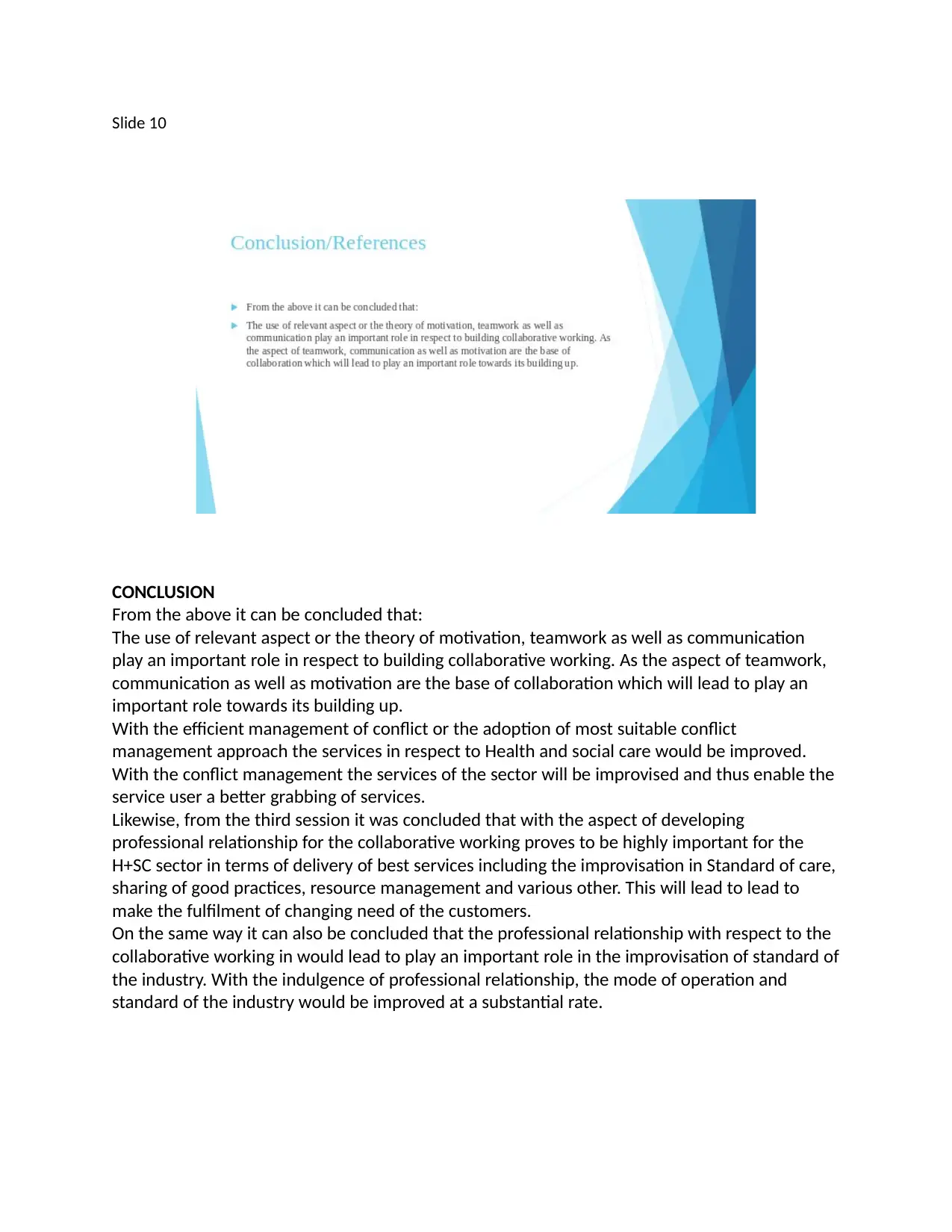
Slide 10
CONCLUSION
From the above it can be concluded that:
The use of relevant aspect or the theory of motivation, teamwork as well as communication
play an important role in respect to building collaborative working. As the aspect of teamwork,
communication as well as motivation are the base of collaboration which will lead to play an
important role towards its building up.
With the efficient management of conflict or the adoption of most suitable conflict
management approach the services in respect to Health and social care would be improved.
With the conflict management the services of the sector will be improvised and thus enable the
service user a better grabbing of services.
Likewise, from the third session it was concluded that with the aspect of developing
professional relationship for the collaborative working proves to be highly important for the
H+SC sector in terms of delivery of best services including the improvisation in Standard of care,
sharing of good practices, resource management and various other. This will lead to lead to
make the fulfilment of changing need of the customers.
On the same way it can also be concluded that the professional relationship with respect to the
collaborative working in would lead to play an important role in the improvisation of standard of
the industry. With the indulgence of professional relationship, the mode of operation and
standard of the industry would be improved at a substantial rate.
CONCLUSION
From the above it can be concluded that:
The use of relevant aspect or the theory of motivation, teamwork as well as communication
play an important role in respect to building collaborative working. As the aspect of teamwork,
communication as well as motivation are the base of collaboration which will lead to play an
important role towards its building up.
With the efficient management of conflict or the adoption of most suitable conflict
management approach the services in respect to Health and social care would be improved.
With the conflict management the services of the sector will be improvised and thus enable the
service user a better grabbing of services.
Likewise, from the third session it was concluded that with the aspect of developing
professional relationship for the collaborative working proves to be highly important for the
H+SC sector in terms of delivery of best services including the improvisation in Standard of care,
sharing of good practices, resource management and various other. This will lead to lead to
make the fulfilment of changing need of the customers.
On the same way it can also be concluded that the professional relationship with respect to the
collaborative working in would lead to play an important role in the improvisation of standard of
the industry. With the indulgence of professional relationship, the mode of operation and
standard of the industry would be improved at a substantial rate.
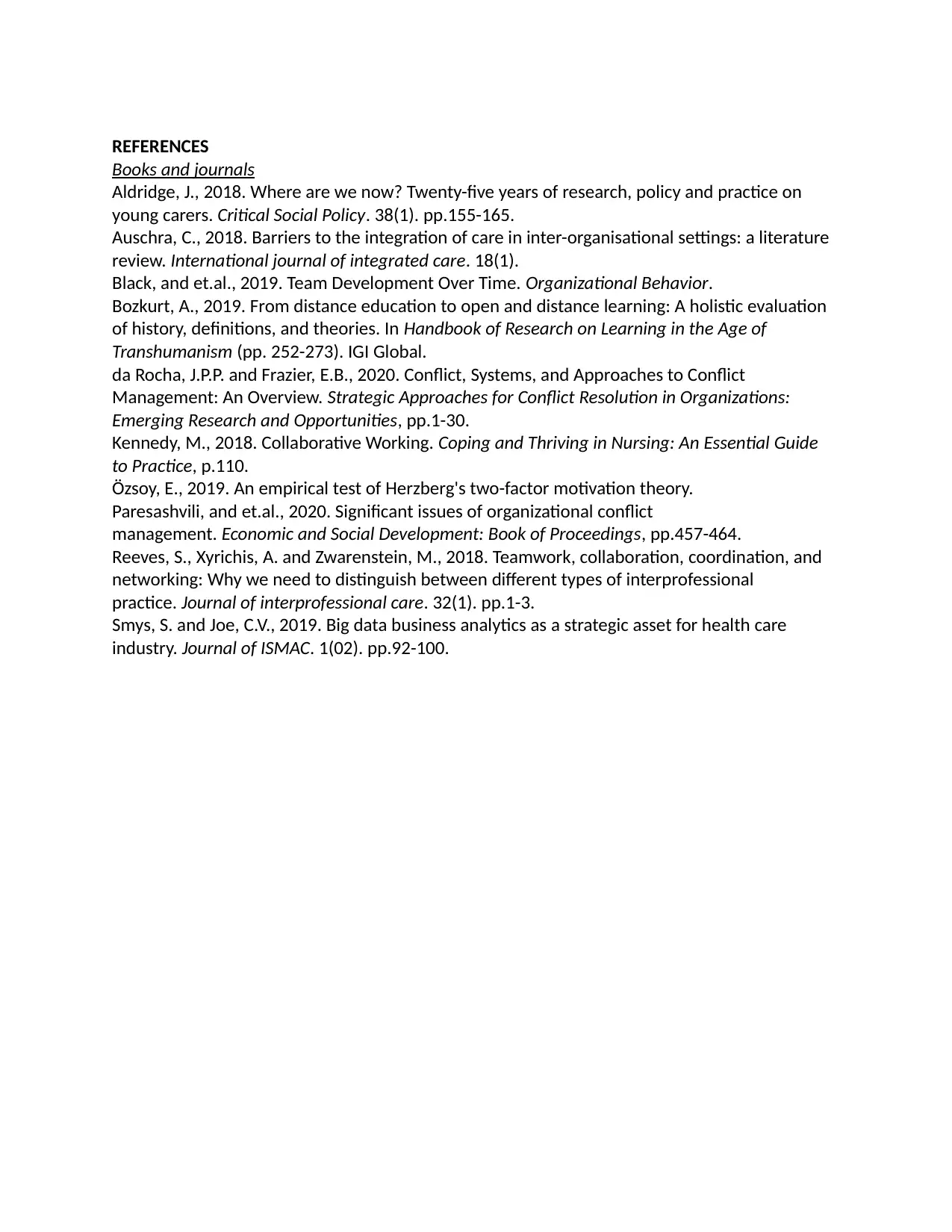
REFERENCES
Books and journals
Aldridge, J., 2018. Where are we now? Twenty-five years of research, policy and practice on
young carers. Critical Social Policy. 38(1). pp.155-165.
Auschra, C., 2018. Barriers to the integration of care in inter-organisational settings: a literature
review. International journal of integrated care. 18(1).
Black, and et.al., 2019. Team Development Over Time. Organizational Behavior.
Bozkurt, A., 2019. From distance education to open and distance learning: A holistic evaluation
of history, definitions, and theories. In Handbook of Research on Learning in the Age of
Transhumanism (pp. 252-273). IGI Global.
da Rocha, J.P.P. and Frazier, E.B., 2020. Conflict, Systems, and Approaches to Conflict
Management: An Overview. Strategic Approaches for Conflict Resolution in Organizations:
Emerging Research and Opportunities, pp.1-30.
Kennedy, M., 2018. Collaborative Working. Coping and Thriving in Nursing: An Essential Guide
to Practice, p.110.
Özsoy, E., 2019. An empirical test of Herzberg's two-factor motivation theory.
Paresashvili, and et.al., 2020. Significant issues of organizational conflict
management. Economic and Social Development: Book of Proceedings, pp.457-464.
Reeves, S., Xyrichis, A. and Zwarenstein, M., 2018. Teamwork, collaboration, coordination, and
networking: Why we need to distinguish between different types of interprofessional
practice. Journal of interprofessional care. 32(1). pp.1-3.
Smys, S. and Joe, C.V., 2019. Big data business analytics as a strategic asset for health care
industry. Journal of ISMAC. 1(02). pp.92-100.
Books and journals
Aldridge, J., 2018. Where are we now? Twenty-five years of research, policy and practice on
young carers. Critical Social Policy. 38(1). pp.155-165.
Auschra, C., 2018. Barriers to the integration of care in inter-organisational settings: a literature
review. International journal of integrated care. 18(1).
Black, and et.al., 2019. Team Development Over Time. Organizational Behavior.
Bozkurt, A., 2019. From distance education to open and distance learning: A holistic evaluation
of history, definitions, and theories. In Handbook of Research on Learning in the Age of
Transhumanism (pp. 252-273). IGI Global.
da Rocha, J.P.P. and Frazier, E.B., 2020. Conflict, Systems, and Approaches to Conflict
Management: An Overview. Strategic Approaches for Conflict Resolution in Organizations:
Emerging Research and Opportunities, pp.1-30.
Kennedy, M., 2018. Collaborative Working. Coping and Thriving in Nursing: An Essential Guide
to Practice, p.110.
Özsoy, E., 2019. An empirical test of Herzberg's two-factor motivation theory.
Paresashvili, and et.al., 2020. Significant issues of organizational conflict
management. Economic and Social Development: Book of Proceedings, pp.457-464.
Reeves, S., Xyrichis, A. and Zwarenstein, M., 2018. Teamwork, collaboration, coordination, and
networking: Why we need to distinguish between different types of interprofessional
practice. Journal of interprofessional care. 32(1). pp.1-3.
Smys, S. and Joe, C.V., 2019. Big data business analytics as a strategic asset for health care
industry. Journal of ISMAC. 1(02). pp.92-100.
⊘ This is a preview!⊘
Do you want full access?
Subscribe today to unlock all pages.

Trusted by 1+ million students worldwide
1 out of 12
Related Documents
Your All-in-One AI-Powered Toolkit for Academic Success.
+13062052269
info@desklib.com
Available 24*7 on WhatsApp / Email
![[object Object]](/_next/static/media/star-bottom.7253800d.svg)
Unlock your academic potential
Copyright © 2020–2025 A2Z Services. All Rights Reserved. Developed and managed by ZUCOL.




